

Pearlers community. World History Maps by Thomas Lessman. Asia 001ad. Vedic period. The Vedic period (or Vedic age) was a period in history during which the Vedas, the oldest scriptures of Hinduism, were composed.
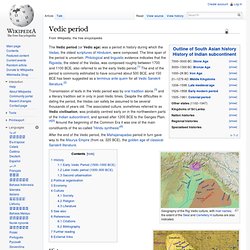
The time span of the period is uncertain. Philological and linguistic evidence indicates that the Rigveda, the oldest of the Vedas, was composed roughly between 1700 and 1100 BCE, also referred to as the early Vedic period.[1] The end of the period is commonly estimated to have occurred about 500 BCE, and 150 BCE has been suggested as a terminus ante quem for all Vedic Sanskrit literature. Transmission of texts in the Vedic period was by oral tradition alone,[3] and a literary tradition set in only in post-Vedic times. Indra. Origins[edit] Aspects of Indra as a deity are cognate to other Indo-European gods; they are either thunder gods such as Thor, Perun, and Zeus, or gods of intoxicating drinks such as Dionysus.

The name of Indra (Indara) is also mentioned among the gods of the Mitanni, a Hurrian-speaking people who ruled northern Syria from ca.1500BC-1300BC.[5] Vedic Indra corresponds to Verethragna of the Zoroastrian Avesta as the noun verethragna- corresponds to Vedic vrtrahan-, which is predominantly an epithet of Indra. Puru. Sarasvati River. The Sarasvati River (Sanskrit: सरस्वती नदी sárasvatī nadī) is one of the main Rigvedic rivers mentioned in ancient Sanskrit texts.
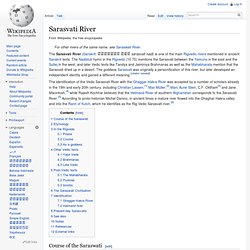
The Nadistuti hymn in the Rigveda (10.75) mentions the Sarasvati between the Yamuna in the east and the Sutlej in the west, and later Vedic texts like Tandya and Jaiminiya Brahmanas as well as the Mahabharata mention that the Sarasvati dried up in a desert. The goddess Sarasvati was originally a personification of this river, but later developed an independent identity and gained a different meaning. [citation needed] The identification of the Vedic Sarasvati River with the Ghaggar-Hakra River was accepted by a number of scholars already in the 19th and early 20th century, including Christian Lassen,[1] Max Müller,[2] Marc Aurel Stein, C.F.
Vedas. Ramayana. The Ramayana (Sanskrit: रामायणम्।
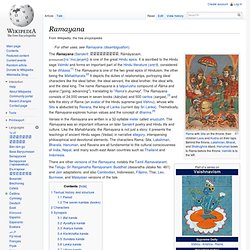
, Rāmāyaṇam, pronounced [rɑːˈmɑːjəɳəm]) is one of the great Hindu epics. It is ascribed to the Hindu sage Valmiki and forms an important part of the Hindu literature (smṛti), considered to be itihāasa.[1] The Ramayana is one of the two great epics of Hinduism, the other being the Mahabharata.[2] It depicts the duties of relationships, portraying ideal characters like the ideal father, the ideal servant, the ideal brother, the ideal wife, and the ideal king. The name Ramayana is a tatpurusha compound of Rāma and ayana ("going, advancing"), translating to "Rama's Journey". Mahabharata. Rigveda. The Rigveda (Sanskrit: ऋग्वेद ṛgveda, a compound of ṛc "praise, verse"[1] and veda "knowledge") is an ancient Indian sacred collection of Vedic Sanskrit hymns.[2] It is counted among the four canonical sacred texts (śruti) of Hinduism known as the Vedas.[3] Some of its verses are still recited as Hindu prayers, at religious functions and other occasions, putting these as the world's oldest religious texts in continued use.[4] The Rigveda contains several mythological and poetical accounts of the origin of the world, hymns praising the gods, and ancient prayers for life, prosperity, etc.[5] It is one of the oldest extant texts in any Indo-European language.[6] Philological and linguistic evidence indicate that the Rigveda was composed in the north-western region of the Indian subcontinent, roughly between 1700–1100 BC[7] (the early Vedic period).
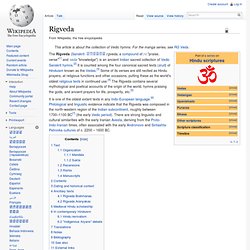
Text Organization Mandala. Upanishads. The Upanishads (/uːˈpænɪˌʃædz, uːˈpɑːnɪˌʃɑːdz/;[1] singular: Sanskrit: उपनिषत्, IAST: Upaniṣat, IPA: [upəniʂət̪]; plural: Sanskrit: उपनिषदः) are a collection of texts in the Vedic Sanskrit language which contain the earliest emergence of some of the central religious concepts of Hinduism, some of which are shared with Buddhism and Jainism.
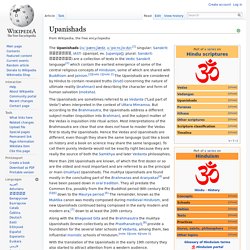
[note 1][note 2] The Upanishads are considered by Hindus to contain revealed truths (Sruti) concerning the nature of ultimate reality (brahman) and describing the character and form of human salvation (moksha). The Upanishads are sometimes referred to as Vedanta ("Last part of Veda") when interpreted in the context of Uttara Mimamsa.
Bhagavad Gita. The Bhagavad Gita (Sanskrit: भगवद्गीता, bhagavad-gītā in IAST, Sanskrit pronunciation: [ˈbʱəɡəʋəd̪ ɡiːˈt̪aː]; lit.

"Song of the Lord"), referred to as simply the Gita, is a 700-verse Hindu scripture in Sanskrit that is part of the Hindu epic Mahabharata. The Gita is set in a narrative framework of a dialogue between Pandava prince Arjuna and his guide and charioteer Krishna. Facing the duty as a warrior to fight the Dharma Yudhha or righteous war between Pandavas and Kauravas, Arjuna is counselled by Krishna to "fulfill his Kshatriya (warrior) duty as a warrior and establishing Dharma. " Inserted in this appeal to kshatriya dharma (chivalry) is "a dialogue [...] between diverging attitudes concerning and methods toward the attainment of liberation (moksha)". Indo-Aryan migration. Indo-Aryan migration models discuss scenarios around the theory of an outside origin of Indo-Aryan peoples, an ascribed ethno-linguistic group that speaks Indo-Aryan languages, the predominant languages of North India. Proponents of Indo-Aryan origin outside of India generally consider migrations into South Asia from Central Asia to have started around 1500 BCE, as a slow diffusion during the Late Harappan period.
The Indo-Aryan migration theories began with the study of the Rig Veda in the mid 19th century by Max Muller, and gradually evolved from a theory of a large scale invasion of a racially and technologically superior people to being a slow diffusion of small numbers of nomadic people that had a disproportionate societal impact on a large urban population. Contemporary claims of Indo-Aryan migrations are drawn from linguistic, genetic, archaeological, literary and cultural sources. Indo-Iranians.
Indo-Iranian peoples are a grouping of ethnic groups consisting of the Indo-Aryan, Iranian, Dardic and Nuristani peoples; that is, speakers of Indo-Iranian languages, a major branch of the Indo-European language family.
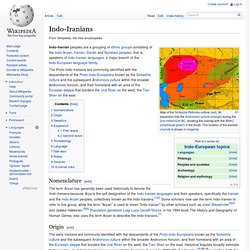
The Proto-Indo-Iranians are commonly identified with the descendants of the Proto-Indo-Europeans known as the Sintashta culture and the subsequent Andronovo culture within the broader Andronovo horizon, and their homeland with an area of the Eurasian steppe that borders the Ural River on the west, the Tian Shan on the east. Nomenclature[edit] Origin[edit] Avesta. The Avesta /əˈvɛstə/ is the primary collection of sacred texts of Zoroastrianism, and is composed in the Avestan language.
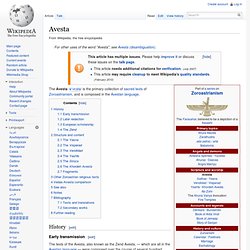
History[edit] Early transmission[edit] Earth Paleogeography. Last glacial period. The last glacial period, popularly known as the Ice Age, was the most recent glacial period within the current ice age occurring during the last years of the Pleistocene, from approximately 110,000 to 12,000 years ago.[1] During this period, there were several changes between glacier advance and retreat.
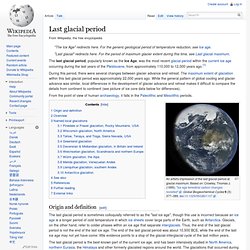
The maximum extent of glaciation within this last glacial period was approximately 22,000 years ago. Scandinavian ice sheet. European prehistory has for over 100 years been divided into three main periods: Stone Age, Bronze Age, and Iron Age. The old Greeks had a different division, the five ages of man: the Golden Age; the Silver Age; Bronze Age I in which brazen-armed, savage, pitiless men fell from the ash trees; Bronze Age II which included the heroes who fought at the walls of Thebe and Troy; and the Iron Age, consisting of the inferior decendants from the age of heroes. Their Iron Age is also our Iron Age, although we call it Antiquity in the Greek part of the world. As regards the ages of gold and silver, those metals were known before bronze, during what we call the Stone Age.
They are at a lower technological level than bronze, and especially iron made from ore. So they tend to be exploited first, and thus also over-exploited first. A glacier is a very long event. A possibility: glaciers, islands, and storms are as much events as they are objects; as events, they are primarily composed of processes of and . A storm is a relatively brief event, a glacier is a very long event, and an island is an even longer event; yet all are, on a geological time scale, ephemeral. In fact, it might be reasonable to understand these events as geology, with all the inherent instability (on a geological time scale, no construct is stable), flux, and unpredictability that is implied by the study of geological events. Three corresponding architectural proposals are inserted between the processes and events described: a landfill park on Staten Island, an artificial ecology inserted into a salt mine in the Galapagos Islands, and a field guide to the landscape of Gateway National Recreation Area.
Schematic diagram of the subdivisions of the accumulation zone of a glacier; source . A glacier is a very quick rock : “Event Surface” drawings from Dynamic Coalition; source . Jökulhlaup. A jökulhlaup (Icelandic pronunciation: [ˈjœːkʏl̥ˌl̥øip]) (literally 'glacier run') is a glacial outburst flood.[1] It is an Icelandic term that has been adopted by the English language. It originally referred to the well-known subglacial outburst floods from Vatnajökull, Iceland, which are triggered by geothermal heating and occasionally by a volcanic subglacial eruption, but it is now used to describe any large and abrupt release of water from a subglacial or proglacial lake/reservoir. Jökulhlaup process[edit] Subglacial water generation[edit] Subglacial meltwater generation is one key to the understanding of subglacial meltwater flow. History of Africa. African States between 500 BCE and 1500 CE. Recent African origin of modern humans. Bantu expansion. The Bantu expansion or Bantu colonisation was a millennia-long series of migrations of speakers of the original proto-Bantu language group.[1] [2] The primary evidence for this great expansion, one of the largest in human history, has been linguistic, namely that the languages spoken in Sub-Equatorial Africa are remarkably similar to each other, to the degree that it is unlikely that they began diverging from each other more than three thousand years ago.
Attempts to trace the exact route of the expansion, to correlate it with archaeological evidence and genetic evidence, have not been conclusive; thus many aspects of the expansion remain in doubt or are highly contested.[3] Early human migrations. Early human migrations began when Homo erectus first migrated out of Africa over the Levantine corridor and Horn of Africa to Eurasia about 1.8 million years ago. The expansion of H. erectus out of Africa was followed by that of Homo antecessor into Europe around 800,000 years ago, followed by Homo heidelbergensis around 600,000 years ago, who was the likely ancestor of both Modern Humans and Neanderthals[1] The ancestors of Homo Sapiens evolved into Modern Humans around 200,000 years ago, in Africa.
Migrations out of Africa occurred some time later: around 125,000 years ago Modern Humans reached the Near East from where they later spread across Asia and Europe.[2] From the Near East, these populations spread east to South Asia by 50,000 years ago, and on to Australia by 40,000 years ago,[3] when for the first time H. sapiens reached territory never reached by H. erectus. H. sapiens reached Europe around 43,000 years ago,[4] eventually replacing the Neanderthal population. Robert G. Map-of-human-migrations.jpg (JPEG-bild, 889x635 pixlar) Cro-Magnon. Cro-Magnon ( i/kroʊˈmænjən/ or US pronunciation: /kroʊˈmæɡnən/; French: [kʁomaɲɔ̃]) is a name that has been used to describe the first early modern humans (early Homo sapiens sapiens) of the European Upper Paleolithic.[1] Current scientific literature prefers the term European Early Modern Humans (EEMH), to the term 'Cro-Magnon,' which has no formal taxonomic status, as it refers neither to a species or subspecies nor to an archaeological phase or culture.[1] The earliest known remains of Cro-Magnon-like humans are radiocarbon dated to 43,000 years before present.[2] The Cro-Magnon are the ancestors of modern Europeans.
Cro-Magnons were robustly built and powerful. The body was generally heavy and solid with a strong musculature. The forehead was fairly straight rather than sloping like in Neanderthals, and with only slight browridges. Recent African origin of modern humans. Genetic history of Europe. The genetic history of Europe is complicated because European populations have a complicated demographic and genetic history, including many successive periods of population growth. The history must be inferred from the patterns of genetic diversity across continents and time. The primary data come from sequences of mitochondrial, Y-chromosome, and autosomal DNA (including single-nucleotide polymorphisms[1]) from modern populations and if available from ancient DNA. History of Europe. Ancient Greece. Roman Empire. Population genetics. Population genetics was a vital ingredient in the emergence of the modern evolutionary synthesis. Its primary founders were Sewall Wright, J.
B. S. Haldane and R. A. Traditionally a highly mathematical discipline, modern population genetics encompasses theoretical, lab and field work. Fundamentals[edit] Introduction to genetics.